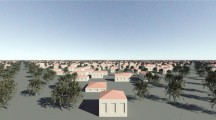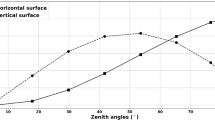Abstract
We propose a calculation method for shortwave radiation flux and longwave radiation flux within the urban canopy and investigate the influence of urban canopy configuration on net radiation flux. In the assumed urban configuration, buildings of equal size are arranged in a regular lattice within the urban canopy. The net shortwave radiation flux and longwave radiation flux within the urban canopy were calculated by the photon tracking method based on the Monte Carlo method. The albedo value obtained by this method shows close agreement with experimental data, and the average sky view factor shows almost perfect agreement with the theoretical value. Moreover, we calculated the urban albedo for the urban canopy configuration including roads and building height distribution.%Moreover, we calculated net radiation within the urban canopy in %consideration of roads and building height distribution.We found that the sky view factor of the ground surface is high when building coverage is low, building height is low, open space by roads exists, and building height is non-uniform. Moreover, we found that the albedo value is high when building height is small, open space by roads is wide, and building height is uniform. The albedo value was found to vary in a complicated manner with change in building coverage.
Similar content being viewed by others
References
Aida, M.: 1982, ‘Urban Albedo as a Function of the Urban Structure-A Model Experiment’ Boundary-Layer Meteorol. 23, 405-413.
Aida, M. andGotoh, M.: 1982, ‘Urban Albedo as a Function of the Urban Structure-A Two-Dimensional Numerical Simulation’ Boundary-Layer Meteorol. 23, 416-424.
Arnfield, A. J.: 1982, ‘An Approach to the Estimation of the Surface Radiative Properties and Radiation Budgets of Cities’ Phys. Geogr. 3, 97-122.
Arnfield, A. J.: 1988, ‘Validation of an Estimation Model for Urban Surface Albedo’ Phys. Geogr. 9, 361-372.
Kimura, F. andTakahashi, S.: 1991, ‘The Effect of Land-Use and Anthropogenic Heating on the Surface Temperature in the Tokyo Metropolitan Area: A Numerical Experiment’ Atmos. Environ. 25B, 155-164.
Kobayashi, T. andTakamura, T.: 1994, ‘Upward Longwave Radiation from a Non-Black Urban Canopy’ Boundary-Layer Meteorol. 69, 201-213.
Kondo, A., Yamaguchi, K., Maeda, K., andTamura, N.: 1998, ‘Calculation Method of Radiation within Urban Canopy Layer and Influence of Radiation on Temperature Distribution’ J. Jpn. Soc. Atmos. Environ. 33, 306-321 (in Japanese).
Nakamura, Y. andOke, T. R.: 1988, ‘Wind, Temperature and Stability Conditions in an East-West Oriented Urban Canyon’ Atmos. Environ. 22, 2691-2700.
Oke, T. R.: 1982, ‘The Energetic Basis of the Urban Heat Island’ Quart. J. Roy. Meteorol. Soc. 108, 1-24.
Saitho, T. S., Shimada, T., andHoshi, H.: 1996, ‘Modeling and Simulation of the Tokyo Urban Heat Island’ Atmos. Environ. 30, 3431-3442.
Swaid, H.: 1993a, ‘Urban Climate Effects of Artificial Heat Source and Ground Shadowing by Buildings’ J. Climate 13, 797-821.
Swaid, H.: 1993b, ‘The Role of Radiative-Convective Interaction in Creating the Microclinate of Urban Street Canyons’ Boundary-Layer Meteorol. 64, 231-259.
Uno, I., Ueda, H., andWakamatsu, S.: 1989, ‘Numerical Modeling of the Nocturnal Urban Boundary Layer’ Boundary-Layer Meteorol. 49, 77-98.
Utagawa, M.: 1984, Calculation Method for Heating, and Air-Conditioning, Ohmsha, Japan, 54 pp. (in Japanese).
Voogt, J. A. andOke, T. R.: 1997, ‘Complete Urban Surface Temperatures’ J. Appl. Meteorol. 36, 1117-1132.
Wilson, N. R. andShaw, R. H.: 1977, ‘A Higher Order Closure Model for Canopy Flow’ J. Appl. Meteorol. 16, 1197-1205.
Yamada, T.: 1982, ‘A Numerical Model Study of Turbulent Airflow in and above a Forest Canopy’ J. Meteorol. Soc. Jpn. 60, 439-454.
Author information
Authors and Affiliations
Rights and permissions
About this article
Cite this article
Kondo, A., Ueno, M., Kaga, A. et al. The Influence Of Urban Canopy Configuration On Urban Albedo. Boundary-Layer Meteorology 100, 225–242 (2001). https://doi.org/10.1023/A:1019243326464
Issue Date:
DOI: https://doi.org/10.1023/A:1019243326464




